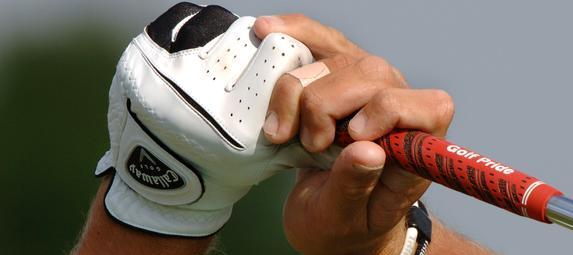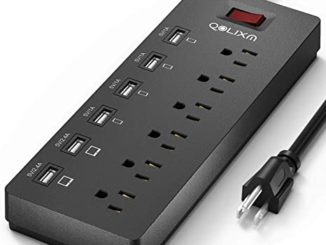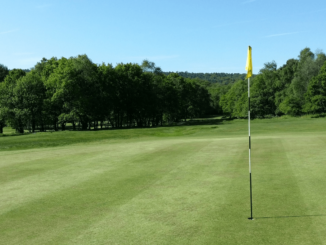
How to Grip the Golf Club like Tiger Woods.
First we need to establish some reference points on your hands so that you can easily place your hands in the correct position for each grip style that will be described. Although this article will give instruction as if you’re a right handed golfer, if you are a Lefty, then use the instruction in the same manner just reversing the hands (Right instead of Left etc.) An easy way to apply this golf grip exercise will be for you to use a marker to draw reference points on your hands and/or a golf glove(s).
Grip Reference Points
The reference points listed below have abbreviated identifiers marked in parenthesis that will be used to identify them throughout the remainder of this golf instruction guide.
Left Hand Marks
- “(AS)” Anatomical Snuffbox – If you hold your hand in front of you with your fingers pointing away from you and your palm facing down, the “Snuffbox” (Actual Anatomical Name) is located on the right side of your wrist at the “base” where the wrist hinges. Continue pointing your fingers away from you and turn your hand counter clockwise pointing your thumb straight up. Flex your wrist so that your hand moves up and down vertically. While doing that, place the tip of the index finger of your Right hand on the “top” of your Left wrist. While your Left hand is flexed vertically upward, you will be able to feel two tendons on top of your Left wrist. In between those two tendons it feels like there is a “pocket. That “pocket” is your “Snuffbox.” Draw a small ¼ inch “X” on top of the “pocket.”
- “(BK)” Dots on your Big Knuckles – Make a fist with your Left hand putting the big knuckles that are located at the base of your fingers on “top” of your fist, palm facing down, and draw a ¼ inch size dot on the “top” of each of your first 3 knuckles.
- “(BIF)” Dot at the base of Index Finger – Looking at your palm, draw a ¼ inch dot at the base of your index finger in the center of the finger on top of the crease or fold in the skin.
- “(D)” D on the Callas Pad at the base of your pinky – With your palm facing you, draw a letter “D” (Short for Distance) atop the Callas at the base of your Pinky finger.
- “(N)” N on the Right side of your palm – With your palm facing you and your fingers pointing straight up, visualize a horizontal line in the middle of your palm. Now draw a letter “N” (short for Neutral) on the right side of your palm on the horizontal line you just visualized. The “N” will be located just below the “D” that you just marked.
- “(C)” C on the Heel Pad – With your palm facing you and your fingers pointing straight up, visualize a vertical line running through the “D” and “N” that you just marked. Draw a letter “C” (Short for Control) on top of the Heel Pad. The letter C should be about 1-1.5 inches below the N that you marked.
- “(TRS)” Line on the top right side of thumb – Point your thumb away from you with the thumbnail on top. Visualize the top center of your thumb, splitting your thumbnail in two equal halves. Focusing on the “right half”, now visualize the center of that half and mark it down the center by drawing a line from the first to second knuckles. This is the top-right side of your thumb.
- “(LV)” V between thumb and forefinger – With your palm facing away from you and your fingers pointing up, hold your thumb against your index finger. A “V” is formed between the top of your thumb and index finger.
Right Hand Marks
- “(BP)” Dot at the base of your Pinky – Looking at your palm, draw a ¼ inch dot at the base of your pinky finger in the center of the finger on top of the crease or fold in the skin.
- “(MIF)” Dot on the middle knuckle of the index finger – Looking at your palm, draw a ¼ inch dot in the middle of your index finger over the middle (2nd) knuckle where the crease is in the skin.
- “(LL)” The Lifeline – With your palm facing you and your fingers pointing up, mark the lifeline in the palm of your hand. It’s the line at the base of your thumb pad that runs from the bottom of your palm up and in-between your thumb and forefinger toward the top right side of your palm.
- “(RV)” V between thumb and forefinger – With your palm facing away from you and your fingers pointing upward, hold your thumb against your index finger. A “V” is formed between the top of your thumb and index finger.
- “?” and “(RV)” support the golf club – Hold your hand in front of you with your fingers pointing straight up, the palm facing left and your thumb facing you. Fold all 4 fingers over at the second knuckle. Tilt your index finger to the right so that it leans backward and notice that your index finger should now look like a question mark (?). Your question mark (?) shaped index finger and the “V” shape between your thumb and index finger (RV) are what supports the golf club at the top of your golf swing.
A Few Rules
- The palms on both hands “Always” face each other – The correct placement of your Right hand on the grip is determined after first placing the Left hand on the grip to ensure the correct positional relationship between both hands. If you hold your hands out in front of you with your fingers outstretched and your thumbs pointing up and press your hands together with the palms facing each other and then rotate your hands clockwise, and counterclockwise, that “relationship” between both hands maximizes your wrists ability to “cock” and “un-cock” during the golf swing and maximize the potential for club head speed. No matter whether your Left hand uses a strong grip or weak golf grip, your Right hand always mirrors what your Left hand is doing so that the palms face each other. One alternative to this rule is taught by some instructors. I’ve seen this grip style called a butterfly grip. Place your palms together in front of you. Leave your thumbs together and separate your hands at the bottom until your hands form a right angle or a 90 degree angle. While maintaining the angle of your hands place the lifeline of your right hand on top of your left thumb. Use this relationship when you place the right hand in “Step Two: The Right Hand Grip” later in this article.
- Each hand’s thumb and forefinger are “Always” held together creating a “V” as mentioned previously in the “Grip Reference Points” section.
- The Right hand “Always” uses a finger grip with the golf shaft lying across the fingers always at the same angle.
Left Hand Grip Variables
Three Grip Angles
The Grip angle is the angle at which the golf shaft runs across the palm and/or fingers of your left hand.
The “Distance” Grip. – This is the one that Tiger Woods uses. Tiger says it gives him the best combination of sensitivity and control.
Advantages
- Maximizes wrists ability to “cock” and “un-cock” for maximum club head speed.
- Good for distance and sensitivity.
Disadvantages
- Requires more strength and skill to square the club face at impact.
A distance grip is achieved by gripping the golf shaft in the hand at an angle that runs from the base of the index finger (BIF) across the base of the fingers to the top of the callus that is located at the base of the pinky finger (D). After wrapping the fingers around the club, most of the gripping strength will be felt in the fingers with “some” pressure on the bottom of your heel pad. The thumb is placed against the index finger (LV).
The “Neutral” Grip. – Good grip for most people.
Advantages
- Gives the most flexibility in terms of shot-making ability.
- Balance between distance and accuracy.
Disadvantages
- None.
A neutral grip is achieved by gripping the golf shaft in the hand at an angle that runs from the base of the index finger (BIF) across the palm to the (N) marking. Wrap the fingers around the club. The gripping strength will be felt between the fingers and firmly against the bottom of your heel pad. The thumb is placed against the index finger (LV).
The “Control” Grip.
Advantages
- Gives maximum control for accuracy.
Disadvantages
- Minimizes wrists ability to “cock” and “un-cock” resulting in less distance.
A Control grip is achieved by gripping the golf shaft in the hand at an angle that runs from the base of the index finger (BIF) across the palm to the (C) marking. Wrap the fingers around the club. The gripping strength will be felt between the fingers, the palm and the top of the heel pad. The thumb is placed against the index finger (LV).
Three Grip Strengths
The “Strength” of the grip is determined by the position of your hand on the grip in comparison to the relative position of the clubface as you rotate your hand around the grip to the left or the right. The reference point used to determine the correct rotational position of the hand on the grip is the anatomical snuffbox (AS). To view the “Strength” of the grip using the (AS), setup to a golf ball as if you are going to hit it with the clubface pointing squarely at the target. Grip the club with your Left hand and look down at the top of your Left hand and determine whether the (AS) is over the top of the club shaft (neutral) or on the left side (weak) or right side of the shaft (strong). The following descriptions will include what the particular “Strength” being described looks like.
The “Weak” Grip.
Advantages
- Helps eliminate hooking the golf ball.
Disadvantages
- Very difficult to hit the ball right to left.
Looking down at the top of your hand, with the clubface pointing squarely toward the target, the anatomical snuffbox (AS) is just off to left side of the grip. Your thumb will be on top of the club shaft and your “V” (LV) points toward your chin and you can see 1 – 1.5 knuckles (BK).
The “Neutral” Grip. – This is the one that Tiger Woods uses. It’s a good grip for most people.
Advantages
- Ideal grip for hitting the golf ball left to right or right to left.
Disadvantages
- Requires more strength to release the club squarely at impact.
Looking down at the top of your hand, with the clubface pointing squarely toward the target, the anatomical snuffbox (AS) is directly over the top of the grip. Your “V” (LV) points toward your right ear and you can see 2 – 2.5 knuckles (BK). Tiger Woods sees 2.5 knuckles (BK).
The “Strong” Grip.
Advantages
- Helps eliminate slicing the golf ball.
- Good for getting more distance.
- Good amateur grip as it requires less strength to square the clubface at impact.
Disadvantages
- Difficult to hit left to right.
Looking down at the top of your hand, with the clubface pointing squarely toward the target, the anatomical snuffbox (AS) is on the right side of the grip. Your “V” (LV) points toward your right shoulder and you can see 3 knuckles (BK).
Three Unifying Grips
These Grips describe how to unify and snug your hands together so that your hands function as a single unit. Note: When placing your hands together, don’t try to smash them together to make them tighter because that looses valuable leverage. Just make them feel unified and snuggly fit together.
The “10 Finger Grip.” – This Grip places all 8 fingers on the golf shaft.
Advantages
- Good leverage.
- Good alternative for kids and women.
Disadvantages
- Less Club head speed especially if the hands are allowed to spread out down the grip and not be snuggly against each other.
A 10 finger grip is achieved by gripping the golf shaft with all of the fingers on the shaft. The outside of your Right hand pinky finger is pressed against the outside of your Left hand index finger.
The “Overlap Grip.” – This is considered by many pros as the preferred method of unifying the hands.
Advantages
- Good for larger hands
Disadvantages
- On people with small hands, the Right hand can tend to slip too far over or too far under the club in an effort to feel snug and fitted.
An overlap grip is achieved by placing all of the hands on the shaft and lifting the pinky of the Right hand off the grip and pointing that finger straight out and then sliding the Right hand toward the Left hand until the third finger on the right hand is placed snuggly against the index finger of the Left hand. Now lay the Right hand pinky finger down over the notch that is formed between the Left hands index finger and second finger.
The “Interlock Grip.” – This is the grip that Tiger Woods likes. Tiger started using it because his idol Jack Nicklaus used it.
Advantages
- Good for smaller hand
Disadvantages
- There is a tendency to grip the club too much in the palm of the Right hand.
An interlock grip is achieved by placing all of the hands on the shaft and lifting the pinky of the Right hand off the grip and pointing that finger straight out and then sliding the Right hand toward the Left hand until the third finger on the right hand is placed snuggly against the index finger of the Left hand. Now raise the index finger of the Left hand off the grip and point it straight out and interlock the Left hand index finger and Right hand pinky finger by laying the Right hand pinky finger down in the crotch between the Left hands index finger and second finger and laying the Left hands index finger down in the crotch between the Right hands pinky finger and third finger.
Maintaining stability throughout the swing
The correct placement of the Left hand down the grip is obtained by allowing ½ inch of the grip to extend out or protrude out beyond the bottom of your hand. If you were gripping the club in both hands, you should be able to see ½ inch of the end of the club shaft grip protruding to ensure that you have the maximum stability of the golf club in your hands throughout the swing. Doing this does not cause you to lose any distance.
Making a complete Grip
Step One: The Left Hand Grip
- Square the clubface to the target line.
- Grip the club ½ inch down from the top of the shaft on the “grip angle” you have chosen; “distance”, “neutral”, or “control”.
- The thumb and forefinger are placed together forming the “V” (LV).
- With the club head resting on the ground and the clubface still square to the target, look down at the top of your Left hand and rotate your Left hand around the club, counterclockwise to the left or clockwise to the right to the appropriate Left hand “grip strength” that you have chosen using your reference marks to verify the correct position as “weak”, “neutral” or “strong”.
Step Two: The Right Hand Grip
- With the golf club still on the ground in your Left hand, the easiest way to visualize how to get the Right hand on the golf grip is by grabbing the golf grip just like you were shaking hands with someone.
- With your Right hands palm approximately facing your left hands palm, place your Right hands fingers on the grip at an angle from the dot at the base of your pinky (BP) to the dot in the middle of your index finger (MIF).
- Place the Lifeline (LL) on the top right side of your Left thumb (TRS).
- Wrap your fingers around the grip. Keep your thumb and forefinger together forming the “V” (RV) and form the question mark (?) with your index finger. The tip of your thumb and index finger on your Right hand will touch or nearly touch. There will probably be a gap between your index finger and the second finger of your Right hand on the grip because of you forming the question mark (?) with your index finger.
Step Three: Unify your Hands
Unify your hands using one of the “Unifying Grips.” Your hands should fit together comfortably and snuggly.
Grip Pressure and Feel
The golf grip should feel snug and unified in your hands, if it doesn’t then un-grip and re-grip making small adjustments if necessary. You should maintain a consistent unchanging grip pressure throughout the entire golf swing. Grip the club as loosely as you can while still maintaining control of the golf club throughout the entire swing.
Regular Practice
After you’ve determined which grip combination you intend to use regularly, practice it until its memorized and use the grip reference points to ensure you place your hands correctly every single time.
Unless otherwise stated, PONIREVO and/or its licensors DO NOT own any intellectual property rights in the website and material on the website. Majority of the site’s content has been scraped and auto posted by a third party artificial intelligence program —– PONIREVO Creation Team.
Proudly WWW.PONIREVO.COM
by Shane Henrie



